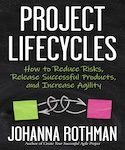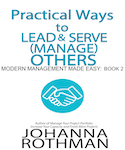About This Title
Pages: 240
Published: July 2016
ISBN: 9781680501759
In Print

Manage Your Project Portfolio, Second Edition
Increase Your Capacity and Finish More Projects
by Johanna Rothman
You have too many projects, and firefighting and multitasking are keeping you from finishing any of them. You need to manage your project portfolio. This fully updated and expanded bestseller arms you with agile and lean ways to collect all your work and decide which projects you should do first, second, and never. See how to tie your work to your organization’s mission and show your managers, your board, and your staff what you can accomplish and when. Picture the work you have, and make those difficult decisions, ensuring that all your strength is focused where it needs to be.
This new edition features a free downloadable workbook that puts you
on the fast track to creating your project portfolio. Pulling together
key checklists, steps, and kanbans from the book, this workbook will
help you get your ideas flowing and create something tangible. You’ll
find the workbook
here![]() .
.
eBook Formats:
PDF for desktop/tablets
epub for Apple Books, e-readers
mobi for Kindle readers
Get all eBook formats here for $26.95 (USD)
Paperback Formats:
Order via Bookshop (U.S. Only)
Please support indie bookstores!
Find indie bookstores in the U.S. Find indie bookstores around the world.
All your projects and programs make up your portfolio. But how much time do you actually spend on your projects, and how much time do you spend on emergency fire drills or waste through multitasking? This book gives you insightful ways to rank all the projects you’re working on and figure out the right staffing and schedule so projects get finished faster.
The trick is adopting lean and agile approaches to projects, whether they’re software projects, projects that include hardware, or projects that depend on chunks of functionality from other suppliers. Find out how to define the mission of your team, group, or department, with none of the buzzwords that normally accompany a mission statement. Armed with the work and the mission, you’ll manage your portfolio better and make those decisions that define the true leaders in the organization.
With this expanded second edition, discover how to scale project portfolio management from one team to the entire enterprise, and integrate Cost of Delay when ranking projects. Additional Kanban views provide even more ways to visualize your portfolio.
Q&A with Manage Your Project Portfolio author Johanna Rothman
What is the project portfolio?
The project portfolio is the ranking of work from #1, #2, #3, to never.
It’s all the work the organization might consider and the relative rank.
How is the project portfolio different from the product roadmap?
A product roadmap optimizes for features—when the team delivers
them—for a given project or program.
A project portfolio optimizes the work through the organization.
When you flow work through teams, the team can take the next chunk of work off a given product roadmap, finish it, and get the next chunk of work. If this project is done enough—so that the product roadmap says, “Yes, release”—then the team can take the next project. That project might be on another product roadmap.
What are the advantages of managing the project portfolio?
Everyone has a project portfolio. If you manage it, you avoid these
problems:
- multitasking
- emergency projects
- not being able to tell when any project will be done
- needing experts, and having to move people around to just the “right” project at just the “right” time.
Aside from avoiding all these time-wasters, everyone focuses on delivering against the organization’s strategy. You’re all working together, not separately.
How does project portfolio management work?
First, collect all the work. I like to start with a team or a couple of
groups, not more than that. Now write a sticky with each project or
chunk of work on it. Place the sticky in the box in the figure to see
where it goes.
You’ll notice there is an Unstaffed row, too. As you work through the project portfolio the first time, you’ll discover work you or your team should not be doing. You might not be able to stop doing it until you have someone who can take the work.
Once you have a draft portfolio, you can work with all the other people across the organization to decide how your portfolio interacts with theirs, how often you want to reevaluate the portfolio, and how to visualize the portfolio.
What will people take away from reading your book?
They will learn how to create the first draft of their project
portfolio. Once they have that, they will learn to rank each chunk of
work, and how to meet to discuss the portfolio as an organization. There
are chapters about measurements, both project/program and portfolio
measures, as well as chapters about scaling, mission, and strategy.
Any manager—project and program managers, directors, VPs, CxOs—either needs to manage the project portfolio or is affected by portfolio decisions. They will be able to create and manage their project portfolios.
What You Need
Resources
Releases:
Contents & Extracts
- Welcome
- How to Read This Book
- Acknowledgements
- Preface

- Meet Your Project Portfolio
- How I Started to Manage My Project Portfolio
- The Project Portfolio Flows Work Through Teams
- What a Project Portfolio Is
- See the High- and Low-Level Views
- Now Try This
- See Your Future
excerpt

- Managing with a Project Portfolio
- Signs You Need to Manage the Project Portfolio
- Managing Without a Project Portfolio
- What Are Your Emergency Projects?
- Lean Approaches to the Project Portfolio
- Why You Should Care About the Project Portfolio
- Now Try This
- Create the First Draft of Your Portfolio
- Know What Work to Collect
- Is the Work a Project or a Program?
- Organize Your Projects into Programs As Necessary
- Organize the Portfolio
- Using Tools to Manage a Portfolio
- Now Try This
- Evaluate Your Projects
excerpt

- Should We Do This Project at All?
- Decide to Commit, Kill, or Transform the Project
- Commit to a Project
- Kill a Project
- How to Kill a Project and Keep It Dead
- Killing a Senior Manager’s Pet Project
- Kill Doomed Projects
- Transform a Project
- Now Try This
- Rank the Portfolio
- Never Rank Alone
- Rank with Cost of Delay
- Rank with Business Value Points
- Remaining Points Provide Metadata
- Rank the Projects by Risk
- Use Your Organization’s Context to Rank Projects
- Who’s Waiting for Your Projects to Be Completed?
- Rank the Work by Your Products’ Position in the Marketplace
- Use Other Comparison Methods to Rank Your Projects
- Beware of Ranking Traps
- Your Project Portfolio Is an Indicator of Your Organization’s Overall Health
- Publish the Portfolio Ranking
- Now Try This
- Collaborate on the Portfolio
- Organize to Commit
- Build Trust
- Define Your Principle so You Can Collaborate
- Articulate Your Mission to Prepare for Collaboration
- Facilitate the Portfolio Evaluation Meeting
- How to Say No to More Work
- Fund Projects Incrementally
- Never Make a Big Commitment
- Discover Barriers to Collaboration
- Who Needs to Collaborate on the Portfolio?
- Now Try This
- Iterate on the Portfolio
excerpt

- Decide When to Review the Portfolio
- Select an Iteration Length for Your Review Cycles
- Defend the Portfolio from Attack
- How to Decide If You Can’t Change Life Cycles, Road Maps, or Budgets
- Make Decisions as Late as Possible
- Now Try This
- Make Portfolio Decisions
- Keep a Parking Lot of Projects
- Decide How Often to Review the Parking Lot
- Decide How to Manage Advanced Projects
- Conduct a Portfolio Evaluation Meeting
- Conduct a Portfolio Evaluation Meeting at Least Quarterly to Start
- Review Your Decisions
- Now Try This
- Visualize Your Project Portfolio
- Who Needs to See What?
- See the Calendar View
- See the Variety of Work
- See the Work in Progress for Many Projects
- Now Try This
- Scaling Portfolio Management to an Enterprise
- Understand How You Work Together Now
- Does Your Organization Suffer from Resource Efficiency Thinking?
- Create a Holistic Perspective of All the Work
- Define Strategy at Your Level
- Ask These Questions for Each Business Unit
- Beware of the Sunk Cost Fallacy
- Start with Strategy and Paper
- Start Here with an Agenda for a Corporate Project Portfolio Meeting
- Scale With Care
- Now Do This
- Evolve Your Portfolio
- Lean Helps You Evolve Your Portfolio Approach
- Choose What to Stabilize
- Stabilize the Timebox
- Stabilize the Number of Work Items in Progress
- Fix the Queue Length for a Team
- When You Need to Fix Cost
- Management Changes When You Stabilize Something About Your Projects
- Now Try This
- Measure the Essentials
- Measure Value
- What You Need to Measure About Your Projects
- Measure Project Velocity: Current and Historical
- Measure Project Cycle and Lead Time
- Measure Cumulative Flow for the Project
- Measure Obstacles Preventing the Team’s Progress
- Measure the Product Backlog Burnup Chart
- Measure Run Rate and Other Cost Data, if Necessary
- Don’t Even Try to Measure Individual Productivity
- What You Need to Measure About the Portfolio
- Measure Capacity by Team, Not by Individual
- People Finish More with Lean and Agile
- Now Try This
- Define Your Mission
- Define the Business You Are In
- What Good Is a Mission, Anyway?
- Define an Actionable Mission for the Organization
- Managers: Do Management Work
- Draft a Mission from Scratch
- Brainstorm the Essentials of a Mission
- Refine the Mission
- Derive Your Mission from Your Work
- How to Define a Mission When No One Else Will
- Beware of the Mission Statement Traps
- Test Your Mission
- Make the Mission Real for Everyone
- Now Try This
- Start Somewhere…But Start
- You’re the Only One Managing the Project Portfolio
- Can I Really Do This?
- Glossary
Author
Johanna Rothman, the “Pragmatic Manager,” offers frank, practical advice that you can immediately apply to your product development challenges.
She helps leaders and teams uncover effective alternatives to their current product development practices. Since one size never fits all, she works with her clients to explore options for what and how to change. The results? Leaders and teams learn to collaborate and focus on outcomes that matter.
With her trademark practicality and humor, Johanna is the author of 21 books, hundreds of articles, and thousands of blog posts about many aspects of management and product development. Find her monthly newsletter and blogs at jrothman.com and createadaptablelife.com.
eBook Formats:
PDF for desktop/tablets
epub for Apple Books, e-readers
mobi for Kindle readers
Get all eBook formats here for $26.95 (USD)
Paperback Formats:
Order via Bookshop (U.S. Only)
Please support indie bookstores!
Find indie bookstores in the U.S. Find indie bookstores around the world.
Related Titles:

About This Title
Pages: 240
Published: July 2016
ISBN: 9781680501759
Edition: 1
In Print

















